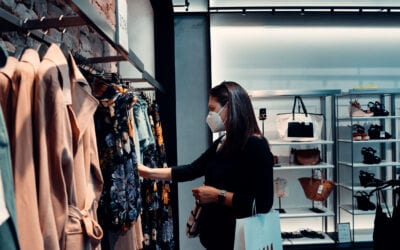Black Friday Risk Considerations

Black Friday is the perfect time to score on deals and get a head-start on holiday shopping. However, any situation in which people gather poses a risk for COVID-19 transmission. Black Friday tends to draw crowds and lines for extended periods of time. Both retailers and customers need to take the necessary precautions to limit the spread of COVID-19.
The safest way to partake in Black Friday this year is through online shopping or curbside pickup. People who are at high-risk for COVID-19 complications (e.g. people over the age of 65 or people with underlying conditions) should especially limit in-person shopping if possible. Additionally, if you have COVID-19, symptoms of COVID-19, are waiting for COVID-19 test results, or have been exposed to someone with COVID-19, do not conduct in-person shopping until your isolation or quarantine period is complete.
If you will be participating in Black Friday this year, here are some tips to help reduce your risk of COVID-19:
Before you go
- Check if the store offers alternative options, such as online shopping or curbside pickup.
- Research the store’s holiday hours and consider going at off-times when there are fewer people in the store.
- Look into whether the store offers special hours for people who are at high-risk for severe illness.
- Make sure to bring your face covering and hand sanitizer.
While you’re shopping
- Remember “Hands, Face, Space”. Wash your hands frequently, cover your face, and make space.
- All retail establishments in Jackson County are required to limit occupancy to 50% of the lowest occupancy load.
- Use hand sanitizer before you enter and after you exit a store. Wash your hands for 20 seconds when you return home.
- Have a list ready to limit time in the store and to avoid touching multiple items.
- Shop only in stores that have implemented safety protocols. For example:
- Sanitize shopping carts between uses
- Touchless payment methods
- Limit occupancy
- Have social-distancing reminders in place
- Avoid stores that attract crowds. For example:
- Stores with in-person, limited supply sales
- Stores with tree lightings, Santa Claus visits, etc.
- Avoid shopping with people who do not live in your household.
Souce
Archives
- June 2025 (3)
- April 2025 (2)
- February 2025 (1)
- January 2025 (2)
- December 2024 (1)
- September 2024 (2)
- August 2024 (2)
- July 2024 (1)
- June 2024 (1)
- February 2024 (1)
- July 2023 (1)
- March 2023 (1)
- October 2022 (1)
- September 2022 (1)
- August 2022 (1)
- July 2022 (2)
- June 2022 (2)
- May 2022 (1)
- April 2022 (4)
- March 2022 (1)
- February 2022 (1)
- January 2022 (2)
- December 2021 (4)
- November 2021 (3)
- September 2021 (2)
- August 2021 (3)
- July 2021 (2)
- June 2021 (1)
- May 2021 (2)
- March 2021 (1)
- December 2020 (6)
- November 2020 (8)
- October 2020 (4)
- September 2020 (7)
- August 2020 (3)
- July 2020 (11)
- May 2020 (2)
- April 2020 (4)
- March 2020 (1)
Categories
- Communicable Disease (4)
- Clinical Services (18)
- Clinical Servcies (1)
- Health Promotions (71)
- Emergency Preparedness (8)





